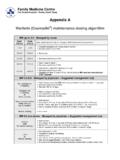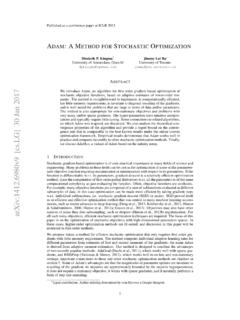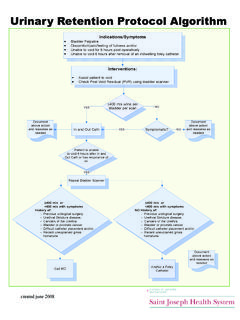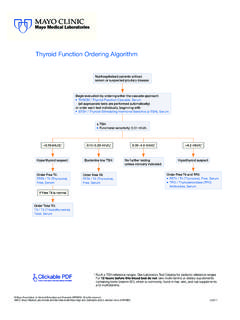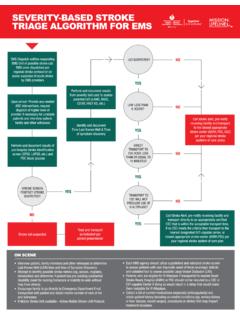Transcription of Selection of Best Sorting Algorithm for a Particular …
1 Selection of best Sorting Algorithm for a Particular Problem Thesis submitted in partial fulfillment of the requirements for the award of degree of Master of Engineering in Computer Science & Engineering By Aditya Dev Mishra (80732001). Under the supervision of Dr. Deepak Garg Asst. Professor CSED. COMPUTER SCIENCE AND ENGINEERING DEPARTMENT. THAPAR UNIVERSITY. PATIALA 147004. JUNE 2009. i ii ABSTRACT. Sorting is the fundamental operation in computer science. Sorting refers to the operation of arranging data in some given order such as increasing or decreasing, with numerical data, or alphabetically, with character data. There are many Sorting algorithms. All Sorting algorithms are problem specific. The Particular Algorithm one chooses depends on the properties of the data and operations one may perform on data. Accordingly, we will want to know the complexity of each Algorithm ; that is, to know the running time f (n) of each Algorithm as a function of the number n of input elements and to analyses the space requirements of our algorithms.
2 Selection of best Sorting Algorithm for a Particular problem depends upon problem definition. Comparisons of Sorting algorithms are based on different scenario. We are comparing Sorting Algorithm according to their complexity, method used like comparison-based or non-comparison based, internal Sorting or external Sorting and also describe the advantages and disadvantages. One can only predict a suitable Sorting Algorithm after analyses the Particular problem the problem is of which type (small number, large number, repeated value). iii TABLE OF CONTENTS. i ii iii TABLE OF iv LIST OF LIST OF 1. Classification of Sorting Method of Why Organization of 2. SOME FUNDAMENTAL Sorting Insertion Bubble Selection Bucket ..11. Quick Radix Counting 3. SOME ADVANCED Sorting Proxmap Merge iv Shell Library Heap Gnome Stack The distribution phase of Stack The collection phase of Stack The distribution phase of The collection phase of Minimax The distribution phase of MinMax The collection phase of MinMax A New Sorting 4.
3 Sorting NETWORK. Bitonic Odd-Even Sorting 5. PROBLEM Problem 6. RESULTS & Problem Definition and Sorting Strength and Comparison of Various Sorting Comparison of Comparison Based Sorting Comparison of Non Comparison Based Sorting v 7. ANNEXURES. I. II. List of vi LIST OF FIGURES. Figure : Example of Insertion ..8. Figure : Example of Selection Figure : Example of Bucket 11. Figure : Example of Quick Figure Example of Radix Figure Example of Counting Figure : Example of Proxmap 18. Figure : Example of Merge Figure : Example of Shell Figure : Example of Heap Figure : Example of Biotonic vii LIST OF TABLES. Table Problem Definition and Sorting Table Strength and Table Comparison of comparison based Sorting Table Comparison of non-comparison based Sorting viii ix CHAPTER 1. INTRODUCTION. Introduction There are many fundamental and advance Sorting algorithms. All Sorting Algorithm are problem specific means they work well on some specific problem and do not work well for all the problems.
4 All Sorting Algorithm apply to specific kind of problems. Some Sorting Algorithm apply to small number of elements, some Sorting Algorithm suitable for floating point numbers, some are fit for specific range ,some Sorting algorithms are used for large number of data, some are used if the list has repeated values. We sort data either in numerical order or lexicographical, Sorting numerical value either in increasing order or decreasing order and alphabetical value like addressee key. One of the fundamental problems of computer science is ordering a list of items. There is a plethora of solutions to this problem, known as Sorting algorithms. Some Sorting algorithms are simple and intuitive, such as the bubble sort. Others, such as the quick sort are extremely complicated, but produce lightning-fast results. The common Sorting algorithms can be divided into two classes by the complexity of their algorithms. There is a direct correlation between the complexity of an Algorithm and its relative efficiency.
5 Algorithmic complexity is generally written in a form known as Big-O notation, where the O represents the complexity of the Algorithm and a value n represents the size of the set the Algorithm is run against. The two classes of Sorting algorithms are O(n2), which includes the bubble, insertion, Selection , and shell, sorts; and O(n log n) which includes the heap, merge, and quick sort. Since the dawn of computing, the Sorting problem has attracted a great deal of research, perhaps due to the complexity of solving it efficiently despite its simple, familiar statement. It is not always possible to say that one Sorting Algorithm is better than another Sorting Algorithm . Performance of various Sorting Algorithm depend upon the data being sorted. Sorting is used in many important applications such that there has been an abundance of performance analysis. However, most previous research is based on the 1. Algorithm s theoretical complexity or their non-cached architecture.
6 As most computers today contain cache, it is important to analyze them based on their cache performance. Quick sort was determined to be a good Sorting Algorithm in terms of average theoretical complexity and cache performance. Sorting is one of the most important and well-studied problems in computer science. Many good algorithms are known which offer various trade-offs in efficiency, simplicity, memory use, and other factors. However, these algorithms do not take into account features of modern computer architectures that significantly influence performance. A. large number of Sorting algorithms have been proposed and their asymptotic complexity, in terms of the number of comparisons or number of iterations, has been carefully analyzed [1]. In the recent past, there has been a growing interest on improvements to Sorting algorithms that do not affect their asymptotic complexity but nevertheless improve performance by enhancing data locality [3, 6, 21].
7 Sorting is a fundamental task that is performed by most computers. It is used frequently in a large variety of important applications. Database applications used by schools, banks, and other institutions all contain Sorting code. Because of the importance of Sorting in these applications, dozens of Sorting algorithms have been developed over the decades with varying complexity. Slow Sorting methods such as bubble sort, insertion sort, and Selection sort have a theoretical complexity of O (n2). Even though these algorithms are very slow for Sorting large arrays, the Algorithm is simple, so they are not useless. If an application only needs to sort small arrays, then it is satisfactory to use one of the simple slow Sorting algorithms as opposed to a faster, but more complicated Sorting Algorithm . For these applications, the increase in coding time and probability of coding mistake in using the faster Sorting Algorithm is not worth the speedup in execution time.
8 Of course, if an application needs a faster Sorting Algorithm , there are certainly many ones available, including quick sort, merge sort, and heap sort. These algorithms have a theoretical complexity of O (n log n). They are much faster than the O (n2) algorithms and can sort large arrays in a reasonable amount of time. However, the cost of these fast Sorting methods is that the Algorithm is much more complex and is harder to correctly code. But 2. the result of the more complex Algorithm is an efficient Sorting method capable of being used to sort very large arrays. Sorting One of the most common applications in computer science is Sorting , through which data are arranged according to their values. Let A be a list of n elements A1,A2 AN in memory. Sorting of A means the operation of rearranging the contents of A so that they are increasing in order (numerically or lexicographically), so that A1 <=A 2< =A3 < = A4 <=AN. Since A has n elements, there are n!
9 Ways that the contents can appear in A. these ways correspond to the n! Permutation of 1, 2, 3 ..n. accordingly, each Sorting Algorithm must take care of these n! Possibilities. Classification of Sorting Algorithms ( i ) Based on data size Sorts are generally classified as either external Sorting or internal Sorting . An internal sort is the sort in which all the data are held in the primary memory during the Sorting process. An external sort uses primary memory for the data currently being sorted and secondary storage for any data that will not fit in the primary memory. ( ii) Based on information about data Comparison based Sorting : A comparison based Algorithm orders a Sorting array by weighing the value of one element against the value of other elements. Algorithms such as quick sort, merge sort, heap sort, bubble sort, and insertion sort are comparison based. Non-comparison based Sorting : A non-comparison based Algorithm sorts an array without consideration of pair wise data elements.
10 Bucket sort, radix sort are example of non comparison based. 3. In computer science and mathematics, a Sorting Algorithm is an Algorithm that puts elements of a list in a certain order. The most-used orders are numerical order and lexicographical order. Efficient Sorting is important to optimizing the use of other algorithms that require sorted lists to work correctly; it is also often useful for producing human-readable output. More formally, the output must satisfy two conditions: The output is in non decreasing order. The output is a permutation, or reordering of the input. Among simple Sorting algorithms, the insertion sort seems to be better for small number of elements. Selection sorts while not bad does not takes advantage of the pre-existing Sorting order. Several more complex algorithms (radix sort, shell sort, merge sort, heap sort and even quite fragile quick sort) are much faster on larger sets. One way to classify Sorting Algorithm is according to their complexity.

